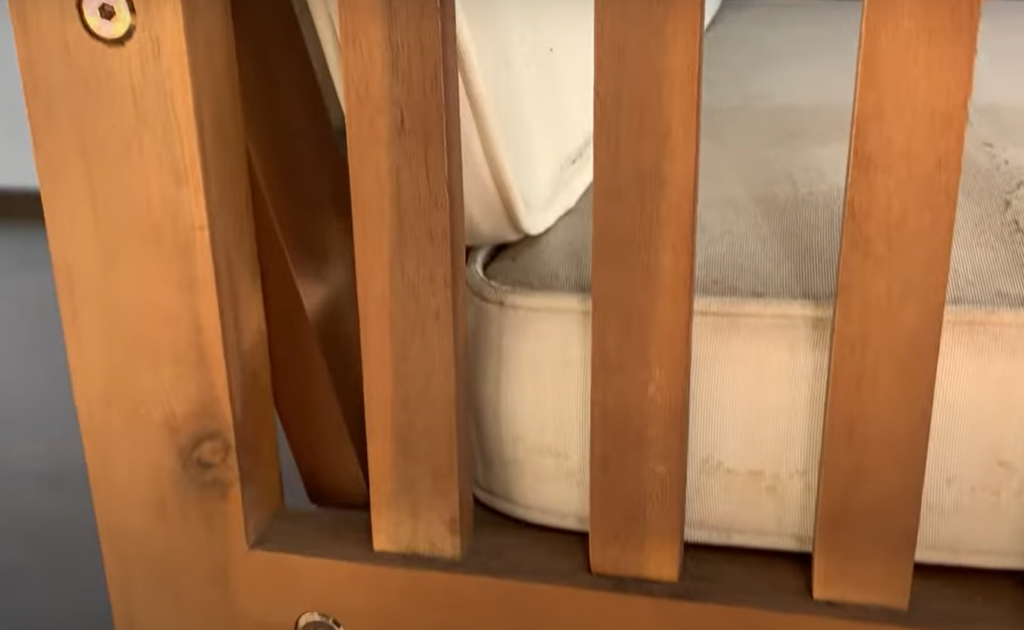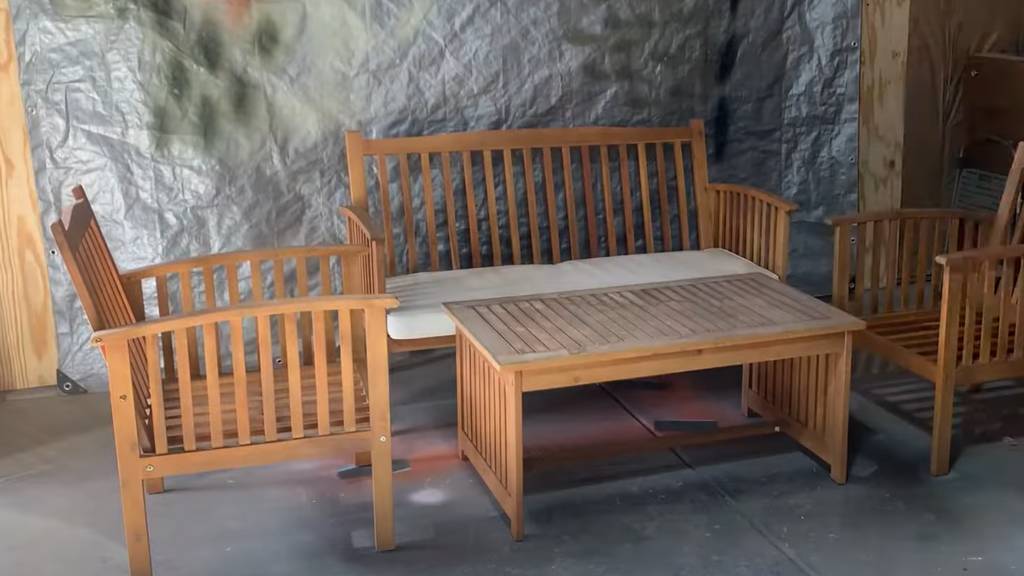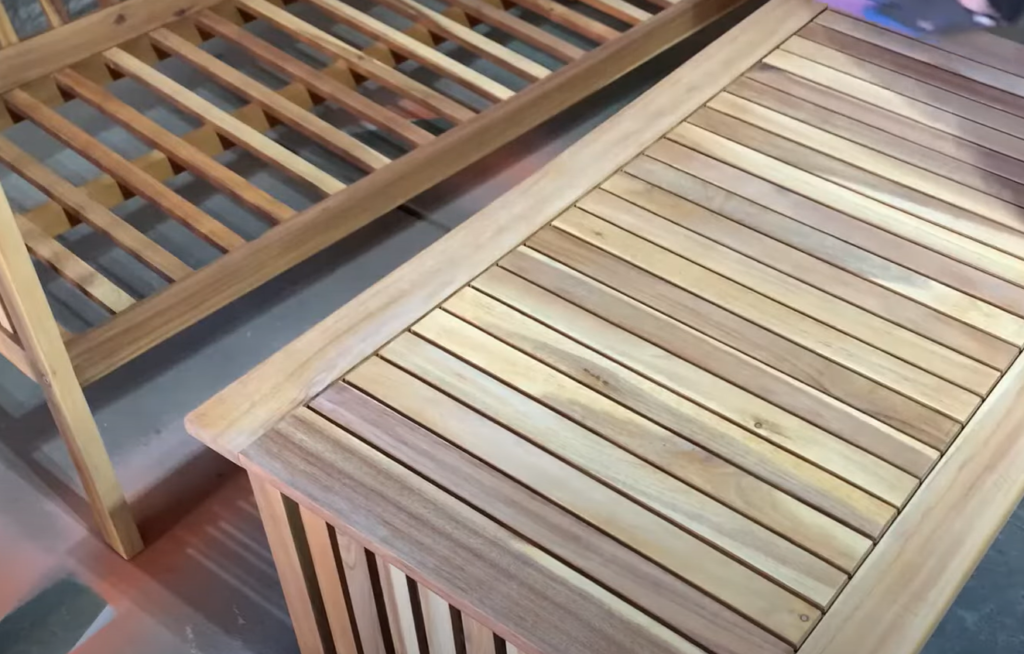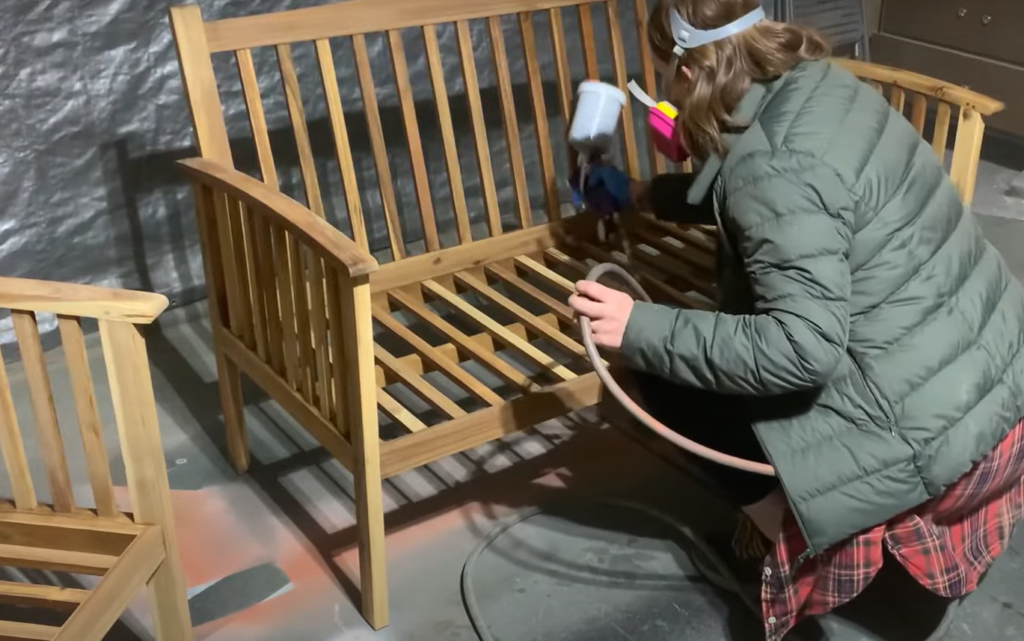Teak, known for its exceptional durability, weather resistance, and timeless elegance, remains a favored selection for outdoor furniture. Yet, after years under the sun and rain, even teak might lose some of its luster, leading homeowners to ponder: can you paint teak outdoor furniture? This guide seeks to answer that question, exploring the advantages and potential pitfalls of painting teak, while also providing step-by-step instructions for those who decide to undertake this home improvement project.
Should You Paint Teak Wood?
Before you grab a paintbrush, take a moment to ponder the distinctive qualities of teak wood. While painting teak wood is indeed feasible, it’s crucial to contemplate its unique characteristics. One of teak’s greatest assets is its natural oil content, which gives the wood its durability and weather-resistance. However, these oils can make it difficult for paint to adhere to the surface, often leading to uneven application and premature peeling.

Furthermore, painting teak may obscure its natural beauty and grain patterns, which many homeowners value. If the color has faded and you wish to refresh your teak furniture, consider using a teak sealer or oil instead. These products can help restore the wood’s vibrant color while maintaining its natural aesthetic.
What To Consider Before Painting Your Teak Furniture
Before painting your teak furniture, consider the following factors:
- The Condition of the Furniture: If the furniture is in good condition with the natural teak color still vibrant, you may want to reconsider painting it and instead, opt for regular cleaning and oiling.
- The Aesthetics: Painting will cover the natural grain and color of the teak, altering its appearance considerably. If you value the aesthetic of natural teak, painting might not be the best option.
- The maintenance: Painted furniture may require more maintenance, as the paint can peel or chip over time, especially in outdoor conditions.
- The Type of Paint: The natural oils present in teak make it incompatible with certain types of paints. Hence, it is imperative to select the appropriate paint that is compatible with teak to ensure optimal results.
- Preparation Time: The process of painting teak furniture can be time-consuming, as it often requires thorough cleaning, sanding, and priming before the actual painting can begin.
- Cost: Depending on the type of paint and the size of the furniture, painting can be a costly endeavor. [1]
Steps In Painting Teak Wood Furniture
Follow these steps to properly paint your teak furniture:
Wash The Wood Surface
Before starting the painting process, it’s crucial to thoroughly wash the surface of the teak wood. Use warm water and mild dish soap for this. With a soft brush, gently scrub the surface to remove dirt, grime, and residual oils.

Thoroughly rinse with clean water and let the furniture fully dry. This may take up to 48 hours, depending on the weather conditions. Ensuring the furniture is completely dry is essential, as any moisture left on the wood can prevent the paint from adhering effectively. Remember to place the furniture in a shaded area when drying to avoid any sun damage.
Fill Any Gaps Or Holes
Once you have confirmed that the furniture is completely dry, proceed to examine the teak wood for any gaps, holes, or cracks. These imperfections may become more noticeable after painting, so it’s crucial to address them beforehand. To do this, use a suitable wood filler that is weather-resistant and can be painted over. Apply the filler according to the manufacturer’s instructions, ensuring that it is smoothly and evenly spread into the imperfections. After applying, give the filler ample time to dry. Once it’s fully dried, you can proceed to sand the filled areas lightly, ensuring they are flush with the rest of the surface. Remember, preparation is key to achieving a smooth, flawless paint finish on your teak furniture. [2]
Sand Your Teak Wood Furniture
Prior to painting, it is crucial to properly sand your teak wood furniture. Sanding removes the surface layer of oils and aids in the adhesion of the primer and paint. To do this, start with a medium-grit sandpaper (around 120-grit) and rub it over the entire surface of the furniture, always going with the grain to avoid scratches. Pay extra attention to any rough or uneven areas.
This will further smooth the surface and prepare it for priming. After completing the sanding process, take a damp cloth and carefully wipe down the furniture, ensuring that all dust and debris are removed before proceeding to the next step.Apply Your Reliable Stain-Blocking Primer
After prepping the teak furniture, the next step involves applying a reliable stain-blocking primer. This product creates a sturdy foundation for the paint to adhere to, ensuring that the natural oils of the teak won’t seep through and affect the final result. Begin by shaking or stirring the primer to ensure it’s well mixed. Apply the primer evenly across the furniture surface using a high-quality brush or roller, making sure to follow the wood grain. Ensure comprehensive coverage, paying attention to every nook and cranny, including corners and crevices.

Allow ample time for the primer to dry fully according to the manufacturer’s instructions before proceeding. To ensure a flawless and long-lasting paint finish on your teak furniture, it is crucial to apply a well-executed layer of primer. [3]
Apply Two Coats Of Paint
Once your primer is thoroughly dry, it’s time to move on to painting. Choose a high-quality outdoor paint that is suitable for wood surfaces. It’s best to apply two coats of paint for an even and robust finish. Using a high-quality brush or roller, apply the initial layer of paint with smooth, continuous strokes, following the natural grain of the wood. Ensure thorough coverage, paying attention to every nook and cranny, including corners and crevices. Once the initial coat has been applied, it is important to let it dry thoroughly by the guidelines provided by the manufacturer. After allowing the first coat to completely dry, proceed to apply the second coat using the same method. Applying two coats of paint will provide a smooth and long-lasting finish that can withstand various weather conditions.
Seal Your Painted Teak Furniture
After the paint has fully dried, the final step is to seal your painted teak furniture. This is an essential step to provide an extra layer of protection and extend the longevity of your paint job. Select a durable outdoor polyurethane sealer with UV protection to shield against sun damage. Apply the sealer using a clean brush, following the grain of the wood. Make sure to thoroughly cover all painted surfaces, including corners and hard-to-reach areas. Let the first coat of sealer dry completely, then apply a second coat for extra durability. Once the sealer has fully dried, your painted teak furniture is ready to be admired and used! Remember, regular maintenance such as cleaning and re-sealing as necessary can help keep your painted teak furniture looking beautiful for years to come. [4]
Is It Okay To Paint Teak Wood Using Chalk Paint?
Certainly! Painting teak wood with chalk paint is a perfectly acceptable approach. Chalk paint can give your teak furniture a unique, textured finish that is both rustic and chic. It adheres well to the wood and requires little to no preparation, making it an ideal choice for those looking for a simple painting option. However, it’s important to note that chalk paint does require a wax or sealant to protect it from the elements, especially if the furniture is intended for outdoor use. Bear in mind, the sealant should be reapplied annually for the best results. Although chalk paint can be an excellent choice for painting teak furniture, it’s important to keep in mind that it often results in a more deliberately weathered finish. So, if you’re seeking a sleek, glossy look, you might want to opt for traditional paint.
How To Keep Your Teak Furniture From Turning Gray
Teak furniture, particularly when used outdoors, naturally weathers over time and can turn gray due to exposure to the elements.

However, there are steps you can take to keep your teak furniture from turning gray.
- Regular Cleaning: Keep its original color by regularly cleaning it. Use a soft-bristle brush and mild soap solution to remove dust, dirt, or mildew. Rinse well and let it dry completely.
- Teak Sealer: Apply teak sealer yearly. This product is different from teak oil and works by preserving the natural oils and resins in the wood, slowing down the weathering process. Make sure the furniture is clean and dry before application. Apply the sealer evenly on all surfaces using a brush.
- Covering: When not in use, especially during harsh weather conditions, cover your teak furniture. Covers protect the wood from rain, snow, and strong sunlight, which could lead to graying.
- Indoor Storage: If possible, store your teak furniture indoors during the winter months. This will protect it from the elements and help preserve its color.
- Restorative Products: If your teak furniture has already turned gray, consider using a teak restorative product. These products are designed to restore the wood’s original color. [5]
FAQ
How do you change the color of teak furniture?
To change the color of teak furniture, you will need to follow a careful process. First, thoroughly clean the furniture with a mild soap and water solution. Ensure the furniture is completely dry. Next, gently sand the furniture surface with fine-grit sandpaper to remove any old sealant and prepare it for staining. Use a damp cloth to gently remove any dust or debris, ensuring a clean and polished surface.
Wipe away any excess stain with a cloth. Always follow the wood grain when applying the stain. Please follow the manufacturer’s instructions and allow the stain to dry completely. Lastly, seal the furniture using a clear, outdoor-grade polyurethane sealer to protect the new color.How do you make teak outdoor furniture look new?
To restore the appearance of teak outdoor furniture and bring back its original beauty, there are a few essential steps that need to be followed. Begin by thoroughly cleaning the furniture with soapy water and a soft brush to remove dirt, grime, and any mildew. After cleaning, allow the furniture to dry completely. To restore the natural color of weathered furniture, apply a teak cleaner. Follow the manufacturer’s instructions for the best results. After cleaning, it’s time to sand the furniture. Use fine-grit sandpaper and sand along the wood grain. This will remove the old layer of wood and bring out the new, yellowish layer beneath. After sanding, rinse the furniture and allow it to fully dry. Next, apply teak sealer to protect and enhance the wood’s natural oils, giving it a fresh, vibrant look. Follow the manufacturer’s instructions for applying the sealer. Finally, maintain your furniture regularly by cleaning it and reapplying the sealer as needed.
Can you restore teak outdoor furniture?
Certainly! It is indeed possible to rejuvenate and restore teak outdoor furniture. Over time, teak furniture can lose its original color and luster but with proper care and maintenance, you can restore its beautiful, natural look. To begin, meticulously clean the furniture using a gentle mixture of mild soap and water to effectively eliminate any accumulated dirt and grime.

If the furniture has grayed, use a teak cleaner following the manufacturer’s instructions to bring back its original color. After cleaning, allow the furniture to thoroughly air dry. After drying, gently sand the entire surface with fine-grit sandpaper to eliminate the weathered layer. To prevent scratching the wood, it is important to always sand in the same direction as the grain. After sanding, make sure to thoroughly rinse the furniture and allow it to dry completely. Apply a teak sealer to protect and enhance the wood’s natural oils, preventing weathering. The sealer should be applied evenly with a brush, covering all surfaces.
What kind of paint do you use on teak?
When it comes to painting teak, you have several options to consider. Acrylic paint is popular for its durability, wide color range, and user-friendly nature. It adheres well to teak and, when used with a primer, can provide a smooth, lasting finish. Oil-based paints are another good option, as they can penetrate the wood’s surface to provide a rich, durable finish. However, they take longer to dry than acrylic paints. Lastly, marine paint is an excellent choice for outdoor teak furniture due to its high resistance to weathering and UV rays. For optimal results, properly prepare the teak surface by cleaning and sanding before applying any type of paint.
Can you change the color of teak wood?
Yes, teak wood color can be changed. The process involves cleaning, sanding, and staining the wood. Begin by thoroughly cleaning the teak to eliminate any dirt or grime present. After the wood has fully dried, gently sand it to eliminate the previous finish and ready the surface for staining. Apply the chosen color stain with a brush, following the wood grain direction. Remove any excess stain by wiping it with a cloth, and allow it to dry based on the instructions provided by the manufacturer. To safeguard the fresh hue and prolong its vibrancy, it is advisable to administer a transparent, outdoor-grade polyurethane sealer.
Can teak be stained gray?
Yes, teak can be stained gray. With a gray wood stain, you can give your teak furniture a contemporary and weathered appearance. Begin by thoroughly cleaning the teak furniture to eliminate any accumulated dirt or grime. Allow it to dry thoroughly. Next, gently sand the teak surface to eliminate any previous finish and to ready the wood for staining. Afterward, apply the gray wood stain using a brush, following the wood grain. Remove excess stain with a cloth and allow it to dry according to the manufacturer’s instructions. Seal the stained wood with an outdoor-grade polyurethane sealer to protect its color and integrity.
Can you make teak less orange?
Yes, it is possible to make teak less orange. Teak possesses a natural hue that ranges from yellow to orange, gradually deepening into a lustrous brown as time passes. If you want to tone down the orange hue, consider using a wood stain in a cooler tone, like a grey or ash color. Start by thoroughly cleaning the teak furniture to remove dirt and grime. After drying, gently sand the teak surface to eliminate the current finish and prepare the wood for staining. Apply your chosen stain in thin layers until you achieve the desired color, wiping away any excess with a clean cloth. Each layer should fully dry according to the manufacturer’s instructions before applying the next. Once you’re happy with the new color, finish by applying a clear, outdoor-grade polyurethane sealer to protect the stain and the wood.
Why does teak turn gray?
Teak wood turns gray as a natural response to exposure to the elements, especially sunlight and moisture. This transformation is part of the wood’s aging process and is due to the gradual erosion of the natural oils in the teak that give it its original color.

As these oils weather away, the wood develops a silver-gray patina over time. This gray color is often appreciated for its aged and weathered look and is a sign that the teak is protecting itself against the elements.
How long will teak outdoor furniture last?
Teak outdoor furniture is widely celebrated for its remarkable durability and long-lasting nature. If properly cared for, high-quality teak furniture can last for approximately 50-75 years, and in some cases even longer. This remarkable lifespan is due to teak’s inherent resistance to rot, insects, and adverse weather conditions. However, the lifespan can be significantly impacted by factors such as the quality of the teak, exposure to severe weather, and how well it is maintained. Regular cleaning and timely teak sealer application can extend the life of your outdoor furniture. Keep it beautiful and functional for years to come.
Why is teak outdoor furniture so expensive?
There are several reasons why teak outdoor furniture is often pricier compared to other types of outdoor furniture. Teak, above all else, is an immensely coveted wood renowned for its unparalleled durability and exceptional resistance to the elements. Teak doesn’t rot or degrade when exposed to weather extremes, making it an ideal choice for outdoor furniture. Moreover, teak possesses an inherent abundance of natural oils, endowing it with exceptional resistance to insects and other pests. The process of harvesting and processing teak is also labor-intensive, which adds to the overall cost. Furthermore, the demand for teak often exceeds the supply, as it comes from specific regions and sustainable practices limit the rate of harvesting. This scarcity and the resulting high demand contribute to the premium price of teak furniture. Although teak outdoor furniture may come with a higher initial cost, it is often regarded as a worthwhile long-term investment because of its exceptional durability and low maintenance needs.
Useful Video: How to Restore & Protect Teak Outdoor Furniture | Teak Oil + Stain & Spar Urethane
Conclusion
In summary, teak stands out as an exceptional option for outdoor furniture given its unmatched durability, ability to withstand the elements, and inherent aesthetic appeal. Although pricier than other wood types, teak furniture is a worthwhile investment for homeowners due to its longevity and minimal maintenance requirements. Whether you wish to maintain the natural color of teak or change its color to better suit your aesthetic preferences, it’s important to remember that regular cleaning and sealing can help extend the lifespan of your teak furniture.
References:
- https://www.tectona.net/en_ww/how-to-paint-your-teak-furniture.html#:~:text=It%20is%20possible%20to%20paint,to%20ensure%20a%20good%20adhesion.&text=Lightly%20sand%20with%20180%20grit,have%20a%20good%20paint%20adhesion.
- https://www.sawinery.net/can-you-paint-teak-wood/
- https://www.farawayfurniture.com/faraway-furniture-blog/painting-teak-garden-furniture-good-idea/
- https://www.gardenbenches.com/blog/restore-teak-furniture/
- https://paintanalyzer.com/can-you-paint-teak-wood/










Leave a Review